#New hubble data
Explore tagged Tumblr posts
Text
NASA’s JWST probes an extreme starburst galaxy - Technology Org
New Post has been published on https://thedigitalinsider.com/nasas-jwst-probes-an-extreme-starburst-galaxy-technology-org/
NASA’s JWST probes an extreme starburst galaxy - Technology Org
An international team of astronomers has used NASA’s James Webb Space Telescope (JWST) to produce the highest-resolution image of spectacular exploding stars ever seen. The Messier 82 (M82) galaxy, located 12 million light-years away in the constellation Ursa Major, is relatively compact in size but hosts a frenzy of star formation activity and is sprouting new stars 10 times faster than the Milky Way galaxy.
On the left is the starburst galaxy M82 as observed by NASA’s Hubble Space Telescope in 2006. The small box at the galaxy’s core corresponds to the area captured so far by the NIRCam (Near-Infrared Camera) instrument on NASA’s James Webb Space Telescope. The red filaments as seen by Webb are the polycyclic aromatic hydrocarbon emission, which traces the shape of the galactic wind. In the Hubble image, light at .814 microns is coloured red, .658 microns is red-orange, .555 microns is green, and .435 microns is blue (filters F814W, F658N, F555W, and F435W, respectively). In the Webb image, light at 3.35 microns is coloured red, 2.50 microns is green, and 1.64 microns is blue (filters F335M, F250M, and F164N, respectively). Image Credit: NASA, ESA, CSA, STScI, A. Bolatto (University of Maryland)
Dr Deanne Fisher from Swinburne University of Technology’s Centre of Astrophysics and Supercomputing led the Australian team, directing the JWST’s NIRCam (Near-Infrared Camera) instrument toward the centre of the so-called ‘starburst galaxy’ to obtain a closer look at the conditions that foster the formation of new stars.
This revealed that the physics involved is very similar to what shapes clouds in our sky, or waves in the water.
“The James Webb Space Telescope really opens a new window to studying the gas in galactic winds. We can now see the tiny building blocks of the wind,” Dr Fisher says.
Star formation continues to maintain a sense of mystery because it is shrouded by curtains of dust and gas, creating an obstacle in observing this process. Fortunately, the JWST’s ability to peer in the infrared is an asset in navigating these murky conditions.
The JWST’s NIRCam instrument was well-suited to trace the structure of the galactic wind via emission from sooty chemical molecules known as polycyclic aromatic hydrocarbons (PAHs). PAHs are like very small dust grains that survive in cooler temperatures but are destroyed in hot conditions.
Much to the team’s surprise, the JWST’s view of the PAH emission highlights the galactic wind’s previously unknown fine structure. Depicted as red filaments, the emission extends away from the central region where the heart of star formation is located. Another unanticipated find was the similar structure between the PAH emission and that of hot, ionised gas.
“The PAH emission is an exciting new tool,” explains Dr Fisher. “PAHs are very fragile. You would expect that when supernovae expose the hot inner material from stars, they would obliterate the colder gas.”
“The fact that the PAHs seem to survive out into the wind is a real challenge to theory. It means there is extra physics that we need to understand. We think that similar physics that shapes clouds in the sky, or waves in water, may be important in these extreme environments of galactic winds.”
Finding structure in lively conditions
Looking at M82 in slightly longer infrared wavelengths, clumpy tendrils represented in red can be seen extending above and below the galaxy’s plane. These gaseous streamers are a galactic wind rushing out from the core of the starburst.
One area of focus was understanding how this galactic wind, which is caused by the rapid rate of star formation and subsequent supernovae, is launching and influencing its surrounding environment. By resolving a central section of M82, scientists could examine where the wind originates and gain insight on how hot and cold components interact within the wind.
A vibrant community of stars
NIRCam images of the very centre of the starburst used an instrument mode that prevented the very bright source from overwhelming the detector.
While dark brown tendrils of heavy dust are threaded throughout M82’s glowing white core even in this infrared view, the JWST’s NIRCam has revealed a level of detail that has historically been obscured. Looking closer toward the centre, small specks depicted in green denote concentrated areas of iron, most of which are supernova remnants. Small patches that appear red signify regions where molecular hydrogen is lit up by a nearby young star’s radiation.
Lighting a path forward
The JWST’s observations of M82 in near-infrared light spur further questions about star formation, some of which the team hopes to answer with additional data gathered with the JWST, including that of another starburst galaxy. Two other papers from this team characterising the stellar clusters and correlations among wind components of M82 are almost finalised.
In the near future, the team will have spectroscopic observations of M82 from the JWST ready for their analysis, as well as complementary large-scale images of the galaxy and wind. Spectral data will help astronomers determine accurate ages for the star clusters and provide a sense of timing for how long each phase of star formation lasts in a starburst galaxy environment. On a broader scale, inspecting the activity in galaxies like M82 can deepen astronomers’ understanding of the early universe.
These findings have been accepted for publication in The Astrophysical Journal.
Source: Swinburne University of Technology
You can offer your link to a page which is relevant to the topic of this post.
#Analysis#Astronomy news#Astrophysics#Blue#box#Building#challenge#chemical#clouds#clusters#Community#Dark#data#detector#directing#dust#Environment#ESA#Filters#focus#Fundamental physics news#Future#galaxies#Galaxy#gas#green#heart#how#Hubble#Hubble Space Telescope
0 notes
Text
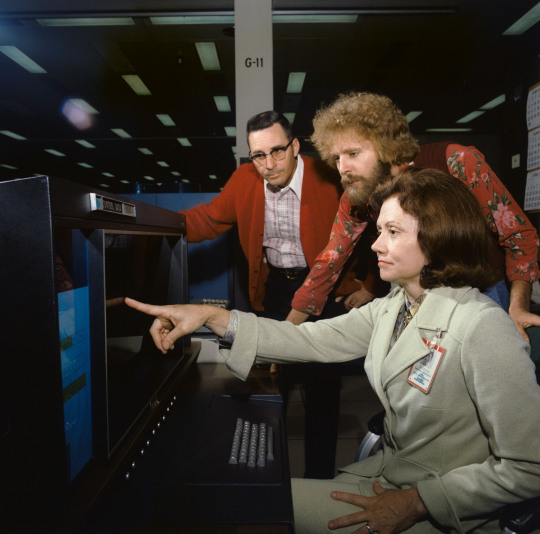
LaRue Burbank, mathematician and computer, is just one of the many women who were instrumental to NASA missions.
4 Little Known Women Who Made Huge Contributions to NASA
Women have always played a significant role at NASA and its predecessor NACA, although for much of the agency’s history, they received neither the praise nor recognition that their contributions deserved. To celebrate Women’s History Month – and properly highlight some of the little-known women-led accomplishments of NASA’s early history – our archivists gathered the stories of four women whose work was critical to NASA’s success and paved the way for future generations.
LaRue Burbank: One of the Women Who Helped Land a Man on the Moon
LaRue Burbank was a trailblazing mathematician at NASA. Hired in 1954 at Langley Memorial Aeronautical Laboratory (now NASA’s Langley Research Center), she, like many other young women at NACA, the predecessor to NASA, had a bachelor's degree in mathematics. But unlike most, she also had a physics degree. For the next four years, she worked as a "human computer," conducting complex data analyses for engineers using calculators, slide rules, and other instruments. After NASA's founding, she continued this vital work for Project Mercury.
In 1962, she transferred to the newly established Manned Spacecraft Center (now NASA’s Johnson Space Center) in Houston, becoming one of the few female professionals and managers there. Her expertise in electronics engineering led her to develop critical display systems used by flight controllers in Mission Control to monitor spacecraft during missions. Her work on the Apollo missions was vital to achieving President Kennedy's goal of landing a man on the Moon.
Eilene Galloway: How NASA became… NASA
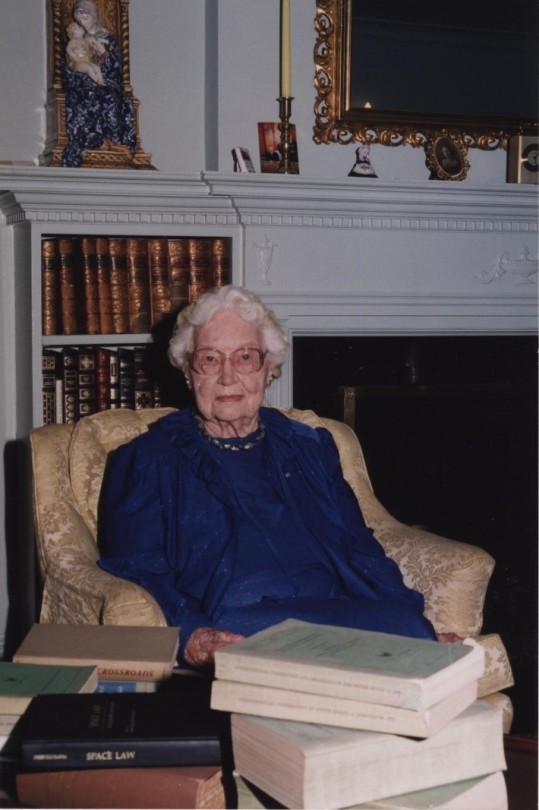
Eilene Galloway wasn't a NASA employee, but she played a huge role in its very creation. In 1957, after the Soviet Union launched Sputnik, Senator Richard Russell Jr. called on Galloway, an expert on the Atomic Energy Act, to write a report on the U.S. response to the space race. Initially, legislators aimed to essentially re-write the Atomic Energy Act to handle the U.S. space goals. However, Galloway argued that the existing military framework wouldn't suffice – a new agency was needed to oversee both military and civilian aspects of space exploration. This included not just defense, but also meteorology, communications, and international cooperation.
Her work on the National Aeronautics and Space Act ensured NASA had the power to accomplish all these goals, without limitations from the Department of Defense or restrictions on international agreements. Galloway is even to thank for the name "National Aeronautics and Space Administration", as initially NASA was to be called “National Aeronautics and Space Agency” which was deemed to not carry enough weight and status for the wide-ranging role that NASA was to fill.
Barbara Scott: The “Star Trek Nerd” Who Led Our Understanding of the Stars

A self-described "Star Trek nerd," Barbara Scott's passion for space wasn't steered toward engineering by her guidance counselor. But that didn't stop her! Fueled by her love of math and computer science, she landed at Goddard Spaceflight Center in 1977. One of the first women working on flight software, Barbara's coding skills became instrumental on missions like the International Ultraviolet Explorer (IUE) and the Thermal Canister Experiment on the Space Shuttle's STS-3. For the final decade of her impressive career, Scott managed the flight software for the iconic Hubble Space Telescope, a testament to her dedication to space exploration.
Dr. Claire Parkinson: An Early Pioneer in Climate Science Whose Work is Still Saving Lives

Dr. Claire Parkinson's love of math blossomed into a passion for climate science. Inspired by the Moon landing, and the fight for civil rights, she pursued a graduate degree in climatology. In 1978, her talents landed her at Goddard, where she continued her research on sea ice modeling. But Parkinson's impact goes beyond theory. She began analyzing satellite data, leading to a groundbreaking discovery: a decline in Arctic sea ice coverage between 1973 and 1987. This critical finding caught the attention of Senator Al Gore, highlighting the urgency of climate change.
Parkinson's leadership extended beyond research. As Project Scientist for the Aqua satellite, she championed making its data freely available. This real-time information has benefitted countless projects, from wildfire management to weather forecasting, even aiding in monitoring the COVID-19 pandemic. Parkinson's dedication to understanding sea ice patterns and the impact of climate change continues to be a valuable resource for our planet.
Make sure to follow us on Tumblr for your regular dose of space!
#NASA#space#tech#technology#womens history month#women in STEM#math#climate science#computer science
2K notes
·
View notes
Text
We finally know what brought light to the dark and formless void of the early Universe. According to data from the Hubble and James Webb Space Telescopes, the origins of the free-flying photons in the early cosmic dawn were small dwarf galaxies that flared to life, clearing the fog of murky hydrogen that filled intergalactic space. A new paper about the research was published in February.
Continue Reading.
195 notes
·
View notes
Text
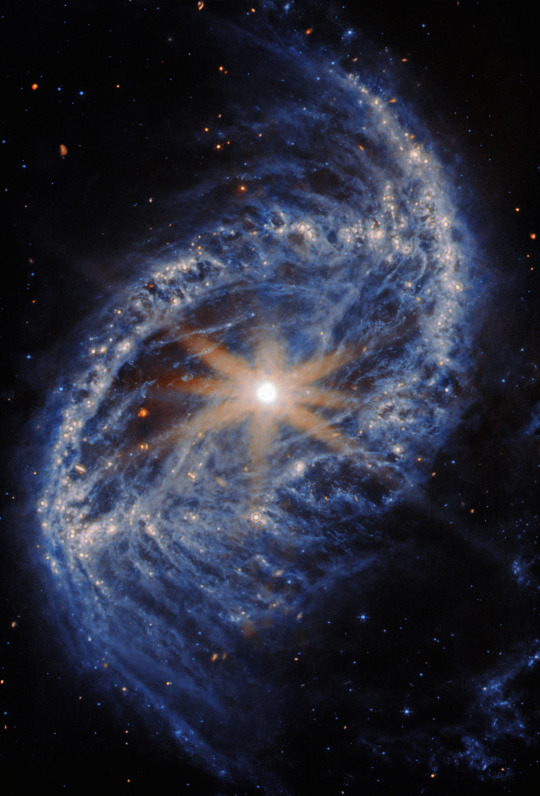
NGC 2566 (MIRI image)
The galaxy filling the frame in this NASA/ESA/CSA James Webb Space Telescope Picture of the Month is NGC 2566, a spiral galaxy located in the constellation Puppis. In this image Webb’s Mid-InfraRed Instrument (MIRI) puts the thick clouds of interstellar dust that suffuse NGC 2566 on display, as well as the galaxy’s compact, bright core.
At 76 million light-years away, NGC 2566 is considered a nearby galaxy, making it an excellent target for studying fine details like star clusters and gas clouds. The new Webb images of NGC 2566 were collected as part of an observing programme (#3707) dedicated to understanding the connections between stars, gas and dust in nearby star-forming galaxies. NGC 2566 is just one of the 55 galaxies in the local Universe examined by Webb for this programme.
To gain a full understanding of the star-formation process in nearby galaxies, astronomers will combine Webb data with observations from other telescopes. At the long-wavelength end of the electromagnetic spectrum, the 66 radio dishes of the Atacama Large Millimeter/submillimeter Array (ALMA) provide a detailed view of the cold, turbulent clouds where stars are born. The NASA/ESA Hubble Space Telescope has also cast its gaze on NGC 2566, and a new Hubble image of this galaxy was released earlier this week. The Hubble data will help researchers take a census of the stars in nearby galaxies, especially the young stars that are bright at the ultraviolet and visible wavelengths to which Hubble is sensitive. Together, the Webb, Hubble and ALMA data provide a rich view of the cold gas, warm dust and brilliant stars in NGC 2566.
The Webb data are part of a Treasury programme, which means that the data may help answer multiple important questions about our Universe. Treasury data are available for use by scientists and the public without a waiting period, amplifying the scientific impact and allowing exploration to begin immediately.
[Image Description: A spiral galaxy, seen close-up. Its core is a round spot that glows intensely bright, crowned by eight long and spikes that extend across the galaxy, artefacts of the telescope’s structure. Its disc is an oval shape with edges made of very thick and cloudy arms of gas and dust, mostly blue but paler and brighter around patches of stars. Wisps of darker dust also fill the inner disc and swirl off the ends of the arms.]
Credits: ESA/Webb, NASA & CSA, A. Leroy;
155 notes
·
View notes
Text
CAN A BLACK HOLE CREATE A STAR??
Blog#359
Wednesday, December 20th, 2023
Welcome back,
Not all black holes are the destructive monsters they're often made out to be, according to new research done with the Hubble Space Telescope.
Scientists from Montana State University published an article in Nature this week that found a star formation in Henize 2-10, a dwarf starburst galaxy — and they say the black hole at the center of that galaxy actually created them.
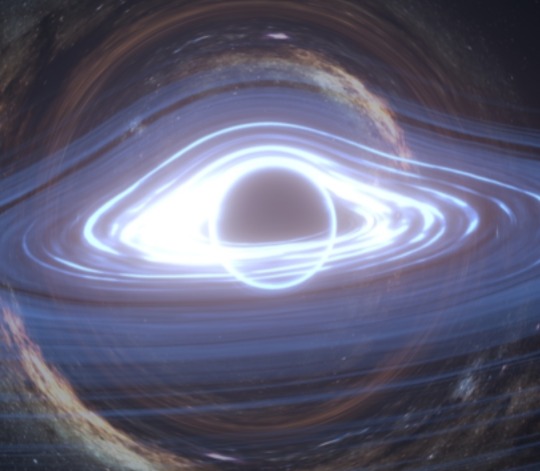
"We conclude that this black-hole outflow triggered the star formation," the authors wrote.
The findings provided insight into a decade-old mystery about whether smaller galaxies had black holes proportional in size to larger ones, according to NASA.

"Ten years ago, as a graduate student thinking I would spend my career on star formation, I looked at the data from Henize 2-10 and everything changed," Amy Reines, a researcher at the University of Virginia and one of the study's authors, told NASA. "From the beginning I knew something unusual and special was happening."
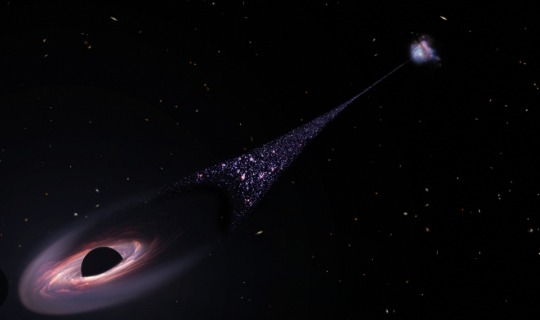
Reines told NASA that she expects even more research into dwarf galaxy black holes in the future. Using them as clues to better understand how supermassive black holes came into existence would solve a persistent problem for astronomers, and NASA reports that of the three leading theories about how black holes are created, none of them stand out as more likely than the others.

"It really has become the big question: where did they come from?" Reines said. "Dwarf galaxies may retain some memory of the black hole seeding scenario that has otherwise been lost to time and space."
It's poetic that an unusually creative black hole defying rules about how black holes are "supposed" to act may actually help scientists understand the most ancient of galactic mysteries.
Originally published on futurism.com
COMING UP!!
(Saturday, December 23rd, 2023)
"HOW MANY TIMES HAS THE SUN TRAVELED AROUND THE MILKY WAY??"
#astronomy#outer space#alternate universe#astrophysics#universe#spacecraft#white universe#parallel universe#space#astrophotography#blackholes#black holes
273 notes
·
View notes
Text

New Hubble Space Telescope data suggests ‘something weird’ is going with our universe, Nasa says | The Independent (the-independent.com)
60 notes
·
View notes
Text

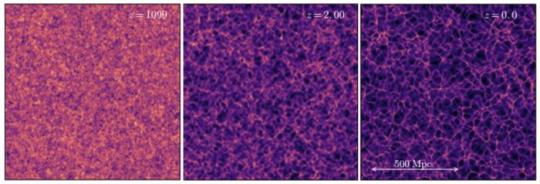
Dark energy 'doesn’t exist' so can't be pushing 'lumpy' Universe apart – study
One of the biggest mysteries in science – dark energy – doesn't actually exist, according to researchers looking to solve the riddle of how the Universe is expanding.
For the past 100 years, physicists have generally assumed that the cosmos is growing equally in all directions. They employed the concept of dark energy as a placeholder to explain unknown physics they couldn't understand, but the contentious theory has always had its problems.
Now a team of physicists and astronomers at the University of Canterbury in Christchurch, New Zealand are challenging the status quo, using improved analysis of supernovae light curves to show that the Universe is expanding in a more varied, "lumpier" way.
The new evidence supports the "timescape" model of cosmic expansion, which doesn't have a need for dark energy because the differences in stretching light aren't the result of an accelerating Universe but instead a consequence of how we calibrate time and distance.
It takes into account that gravity slows time, so an ideal clock in empty space ticks faster than inside a galaxy.
The model suggests that a clock in the Milky Way would be about 35 per cent slower than the same one at an average position in large cosmic voids, meaning billions more years would have passed in voids. This would in turn allow more expansion of space, making it seem like the expansion is getting faster when such vast empty voids grow to dominate the Universe.
Professor David Wiltshire, who led the study, said: "Our findings show that we do not need dark energy to explain why the Universe appears to expand at an accelerating rate.
"Dark energy is a misidentification of variations in the kinetic energy of expansion, which is not uniform in a Universe as lumpy as the one we actually live in."
He added: "The research provides compelling evidence that may resolve some of the key questions around the quirks of our expanding cosmos.
"With new data, the Universe's biggest mystery could be settled by the end of the decade."
The new analysis has been published in the journal Monthly Notices of the Royal Astronomical Society Letters.
Dark energy is commonly thought to be a weak anti-gravity force which acts independently of matter and makes up around two thirds of the mass-energy density of the Universe.
The standard Lambda Cold Dark Matter (ΛCDM) model of the Universe requires dark energy to explain the observed acceleration in the rate at which the cosmos is expanding.
Scientists base this conclusion on measurements of the distances to supernova explosions in distant galaxies, which appear to be farther away than they should be if the Universe's expansion were not accelerating.
However, the present expansion rate of the Universe is increasingly being challenged by new observations.
Firstly, evidence from the afterglow of the Big Bang – known as the Cosmic Microwave Background (CMB) – shows the expansion of the early Universe is at odds with current expansion, an anomaly known as the "Hubble tension".
In addition, recent analysis of new high precision data by the Dark Energy Spectroscopic Instrument (DESI) has found that the ΛCDM model does not fit as well as models in which dark energy is "evolving" over time, rather than remaining constant.
Both the Hubble tension and the surprises revealed by DESI are difficult to resolve in models which use a simplified 100-year-old cosmic expansion law – Friedmann's equation.
This assumes that, on average, the Universe expands uniformly – as if all cosmic structures could be put through a blender to make a featureless soup, with no complicating structure. However, the present Universe actually contains a complex cosmic web of galaxy clusters in sheets and filaments that surround and thread vast empty voids.
Professor Wiltshire added: "We now have so much data that in the 21st century we can finally answer the question – how and why does a simple average expansion law emerge from complexity?
"A simple expansion law consistent with Einstein's general relativity does not have to obey Friedmann's equation."
The researchers say that the European Space Agency's Euclid satellite, which was launched in July 2023, has the power to test and distinguish the Friedmann equation from the timescape alternative. However, this will require at least 1,000 independent high quality supernovae observations.
When the proposed timescape model was last tested in 2017 the analysis suggested it was only a slightly better fit than the ΛCDM as an explanation for cosmic expansion, so the Christchurch team worked closely with the Pantheon+ collaboration team who had painstakingly produced a catalogue of 1,535 distinct supernovae.
They say the new data now provides "very strong evidence" for timescape. It may also point to a compelling resolution of the Hubble tension and other anomalies related to the expansion of the Universe.
Further observations from Euclid and the Nancy Grace Roman Space Telescope are needed to bolster support for the timescape model, the researchers say, with the race now on to use this wealth of new data to reveal the true nature of cosmic expansion and dark energy.
TOP IMAGE: This graphic offers a glimpse of the history of the Universe, as we currently understand it. The cosmos began expanding with the Big Bang but then around 10 billion years later it strangely began to accelerate thanks to a theoretical phenomenon termed dark energy. Credit: NASA
LOWER IMAGE: This graphic shows the emergence of a cosmic web in a cosmological simulation using general relativity. From left, 300,000 years after the Big Bang to right, a Universe similar to ours today. The dark regions are void of matter, where an ideal clock would run faster and allow more time for the expansion of space. The lighter purple regions are denser so clocks would run slower, meaning under the "timescape" model of cosmology that acceleration of the Universe's expansion is not uniform. Credit: Hayley Macpherson, Daniel Price, Paul Lasky / Physical Review D 99 (2019) 063522
33 notes
·
View notes
Photo
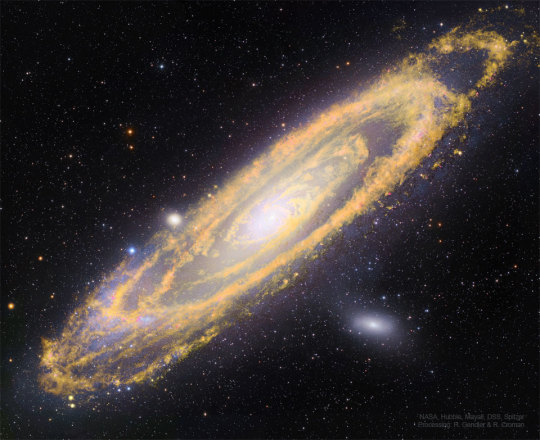
2023 October 7
The Once and Future Stars of Andromeda Image Credit: NASA, NSF, NOAJ, Hubble, Subaru, Mayall, DSS, Spitzer; Processing & Copyright: Robert Gendler & Russell Croman
Explanation: This picture of Andromeda shows not only where stars are now, but where stars will be. The big, beautiful Andromeda Galaxy, M31, is a spiral galaxy a mere 2.5 million light-years away. Image data from space-based and ground-based observatories have been combined here to produce this intriguing composite view of Andromeda at wavelengths both inside and outside normally visible light. The visible light shows where M31's stars are now, highlighted in white and blue hues and imaged by the Hubble, Subaru, and Mayall telescopes. The infrared light shows where M31's future stars will soon form, highlighted in orange hues and imaged by NASA's Spitzer Space Telescope. The infrared light tracks enormous lanes of dust, warmed by stars, sweeping along Andromeda's spiral arms. This dust is a tracer of the galaxy's vast interstellar gas, raw material for future star formation. Of course, the new stars will likely form over the next hundred million years or so. That's well before Andromeda merges with our Milky Way Galaxy in about 5 billion years.
∞ Source: apod.nasa.gov/apod/ap231007.html
264 notes
·
View notes
Text
Discovery Alert! In a new discovery released on Jan 08, 2024 James Webb Telescope and Chandra Solve Cassiopeia A's Green Monster Riddle.
Discovery Alert! In a new discovery released on Jan 08, 2023 James Webb Telescope and Chandra Solve Cassiopeia A's Green Monster Riddle. Read more here

Dive into the celestial wonders of Cassiopeia A as NASA's James Webb Space Telescope and Chandra X-ray Observatory join forces to decode the enigma of the 'Green Monster.' 🌠✨ This collaboration has unveiled a mesmerizing image resembling an electric light show in space – think red clouds, glowing white streaks, fiery flames, and a central region that's practically a cosmic green lightning display. ⚡️💫
Chandra's X-rays in striking blue illuminate the hot gas, predominantly from the supernova debris, unveiling elements like silicon and iron. These elements form thin arcs in the outer reaches of the remnant, revealing the aftermath of a celestial explosion. 🌪️
Webb's infrared magic, painted in red, green, and blue, exposes the warmth of dust embedded in the hot gas seen by Chandra and the presence of cooler supernova debris. Meanwhile, the Hubble data adds a sprinkle of stars, turning this cosmic canvas into a dazzling tapestry. 🌈✨
Get ready to embark on a journey through the cosmos, where science meets art and the mysteries of Cassiopeia A are unraveled. 🌌💙 #WebbTelescope #ChandraObservatory #GreenMonsterMystery #CosmicDiscovery #SpaceArtistry
101 notes
·
View notes
Text
A Stellar Bouquet

This image, released on Feb. 12, 2025, is the deepest X-ray image ever made of the spectacular star forming region called 30 Doradus. By combining X-ray data from NASA’s Chandra X-ray Observatory (blue and green) with optical data from NASA’s Hubble Space Telescope (yellow) and radio data from the Atacama Large Millimeter/submillimeter Array (orange), this stellar arrangement comes alive.
Otherwise known as the Tarantula Nebula, 30 Dor is located about 160,000 light-years away in a small neighboring galaxy to the Milky Way known as the Large Magellanic Cloud. Because it one of the brightest and populated star-forming regions to Earth, 30 Dor is a frequent target for scientists trying to learn more about how stars are born.
Learn more about this new image and what it reveals.
Image credit: X-ray: NASA/CXC/Penn State Univ./L. Townsley et al.; Infrared: NASA/JPL-CalTech/SST; Optical: NASA/STScI/HST; Radio: ESO/NAOJ/NRAO/ALMA; Image Processing: NASA/CXC/SAO/J. Schmidt, N. Wolk, K. Arcand
#dark-rx#Astrophysics#Space#Physics#Astronomy#Stars#BlackHoles#GravitationalWaves#QuantumPhysics#DarkMatter#DarkEnergy#BigBang#Exoplanets#Relativity#Cosmology#NASA#Science#FerretingOutTheUniverse#AstroPhysicsLove#AstrophysicsCommunity#PlanetaryScience#TheoreticalPhysics#AstroPhysicsResearch#AstroPhysicsFun#SpaceExploration#StellarEvolution#AstroPhysicsFan
23 notes
·
View notes
Text
NASA Inspires Your Crafty Creations for World Embroidery Day
It’s amazing what you can do with a little needle and thread! For #WorldEmbroideryDay, we asked what NASA imagery inspired you. You responded with a variety of embroidered creations, highlighting our different areas of study.
Here’s what we found:
Webb’s Carina Nebula
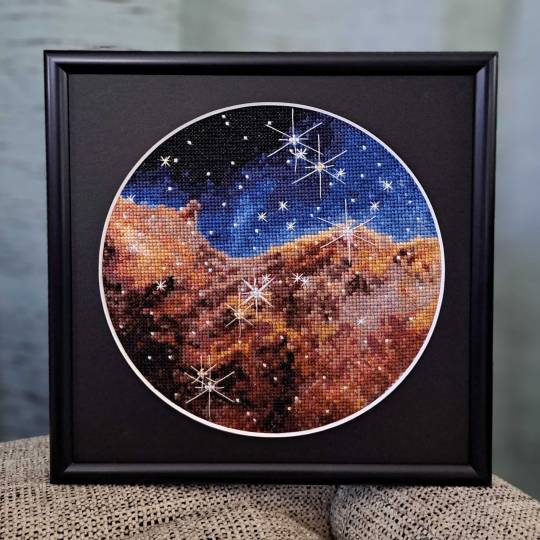
Wendy Edwards, a project coordinator with Earth Science Data Systems at NASA, created this embroidered piece inspired by Webb’s Carina Nebula image. Captured in infrared light, this image revealed for the first time previously invisible areas of star birth. Credit: Wendy Edwards, NASA. Pattern credit: Clare Bray, Climbing Goat Designs
Wendy Edwards, a project coordinator with Earth Science Data Systems at NASA, first learned cross stitch in middle school where she had to pick rotating electives and cross stitch/embroidery was one of the options. “When I look up to the stars and think about how incredibly, incomprehensibly big it is out there in the universe, I’m reminded that the universe isn’t ‘out there’ at all. We’re in it,” she said. Her latest piece focused on Webb’s image release of the Carina Nebula. The image showcased the telescope’s ability to peer through cosmic dust, shedding new light on how stars form.
Ocean Color Imagery: Exploring the North Caspian Sea
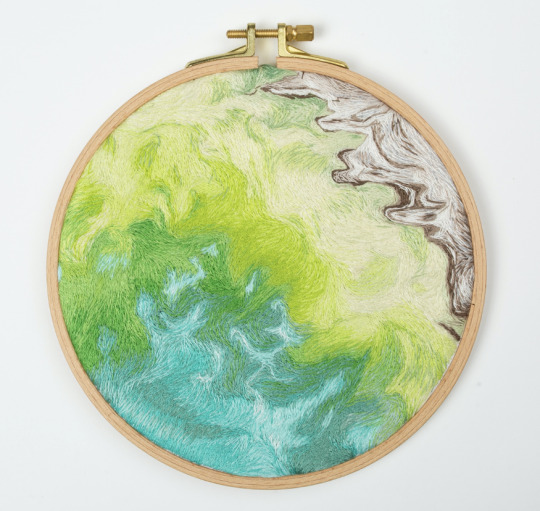
Danielle Currie of Satellite Stitches created a piece inspired by the Caspian Sea, taken by NASA’s ocean color satellites. Credit: Danielle Currie/Satellite Stitches
Danielle Currie is an environmental professional who resides in New Brunswick, Canada. She began embroidering at the beginning of the Covid-19 pandemic as a hobby to take her mind off the stress of the unknown. Danielle’s piece is titled “46.69, 50.43,” named after the coordinates of the area of the northern Caspian Sea captured by LandSat8 in 2019.
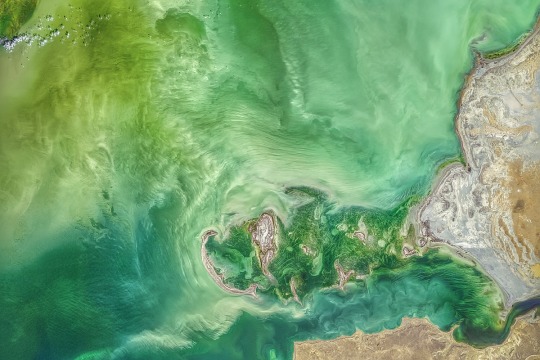
An image of the Caspian Sea captured by Landsat 8 in 2019. Credit: NASA
Two Hubble Images of the Pillars of Creation, 1995 and 2015
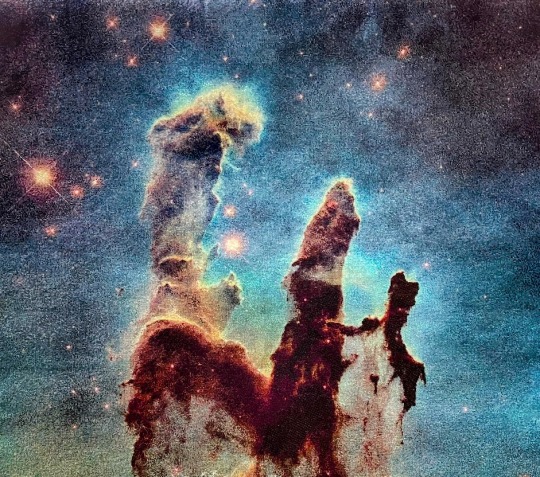
Melissa Cole of Star Stuff Stitching created an embroidery piece based on the Hubble image Pillars of Creation released in 1995. Credit: Melissa Cole, Star Stuff Stitching
Melissa Cole is an award-winning fiber artist from Philadelphia, PA, USA, inspired by the beauty and vastness of the universe. They began creating their own cross stitch patterns at 14, while living with their grandparents in rural Michigan, using colored pencils and graph paper. The Pillars of Creation (Eagle Nebula, M16), released by the Hubble Telescope in 1995 when Melissa was just 11 years old, captured the imagination of a young person in a rural, religious setting, with limited access to science education.
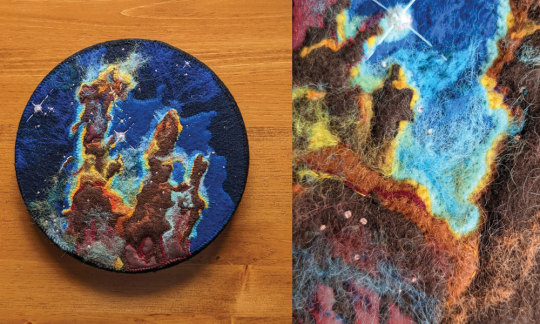
Lauren Wright Vartanian of the shop Neurons and Nebulas created this piece inspired by the Hubble Space Telescope’s 2015 25th anniversary re-capture of the Pillars of Creation. Credit: Lauren Wright Vartanian, Neurons and Nebulas
Lauren Wright Vartanian of Guelph, Ontario Canada considers herself a huge space nerd. She’s a multidisciplinary artist who took up hand sewing after the birth of her daughter. She’s currently working on the illustrations for a science themed alphabet book, made entirely out of textile art. It is being published by Firefly Books and comes out in the fall of 2024. Lauren said she was enamored by the original Pillars image released by Hubble in 1995. When Hubble released a higher resolution capture in 2015, she fell in love even further! This is her tribute to those well-known images.
James Webb Telescope Captures Pillars of Creation
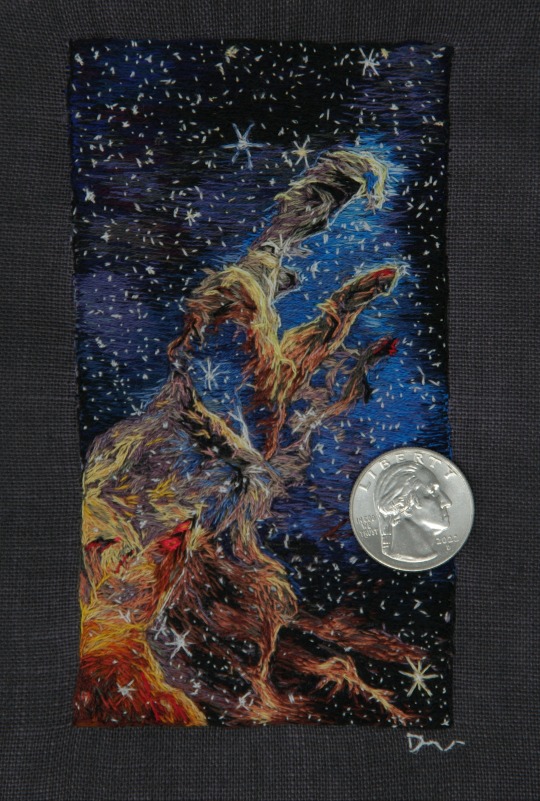
Darci Lenker of Darci Lenker Art, created a rectangular version of Webb’s Pillars of Creation. Credit: Darci Lenker of Darci Lenker Art
Darci Lenker of Norman, Oklahoma started embroidery in college more than 20 years ago, but mainly only used it as an embellishment for her other fiber works. In 2015, she started a daily embroidery project where she planned to do one one-inch circle of embroidery every day for a year. She did a collection of miniature thread painted galaxies and nebulas for Science Museum Oklahoma in 2019. Lenker said she had previously embroidered the Hubble Telescope’s image of Pillars of Creation and was excited to see the new Webb Telescope image of the same thing. Lenker could not wait to stitch the same piece with bolder, more vivid colors.
Milky Way
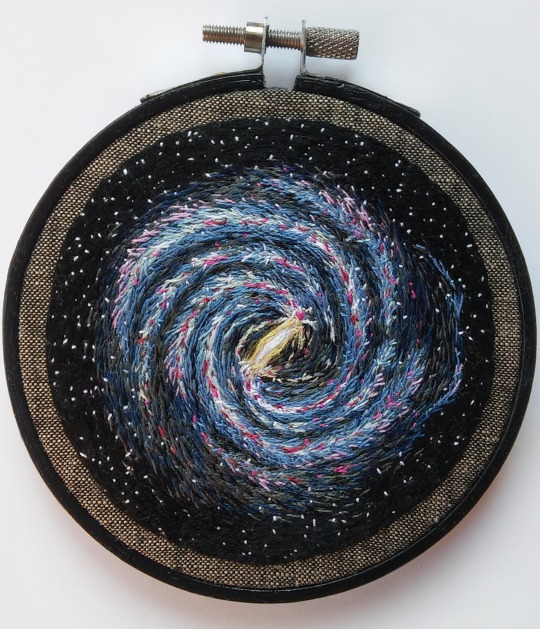
Darci Lenker of Darci Lenker Art was inspired by NASA’s imaging of the Milky Way Galaxy. Credit: Darci Lenker
In this piece, Lenker became inspired by the Milky Way Galaxy, which is organized into spiral arms of giant stars that illuminate interstellar gas and dust. The Sun is in a finger called the Orion Spur.
The Cosmic Microwave Background
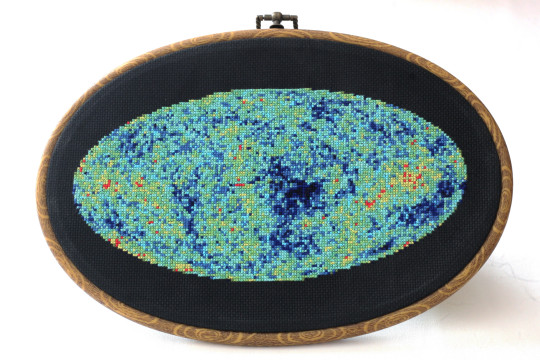
This image shows an embroidery design based on the cosmic microwave background, created by Jessica Campbell, who runs Astrostitches. Inside a tan wooden frame, a colorful oval is stitched onto a black background in shades of blue, green, yellow, and a little bit of red. Credit: Jessica Campbell/ Astrostitches
Jessica Campbell obtained her PhD in astrophysics from the University of Toronto studying interstellar dust and magnetic fields in the Milky Way Galaxy. Jessica promptly taught herself how to cross-stitch in March 2020 and has since enjoyed turning astronomical observations into realistic cross-stitches. Her piece was inspired by the cosmic microwave background, which displays the oldest light in the universe.

The full-sky image of the temperature fluctuations (shown as color differences) in the cosmic microwave background, made from nine years of WMAP observations. These are the seeds of galaxies, from a time when the universe was under 400,000 years old. Credit: NASA/WMAP Science Team
GISSTEMP: NASA’s Yearly Temperature Release
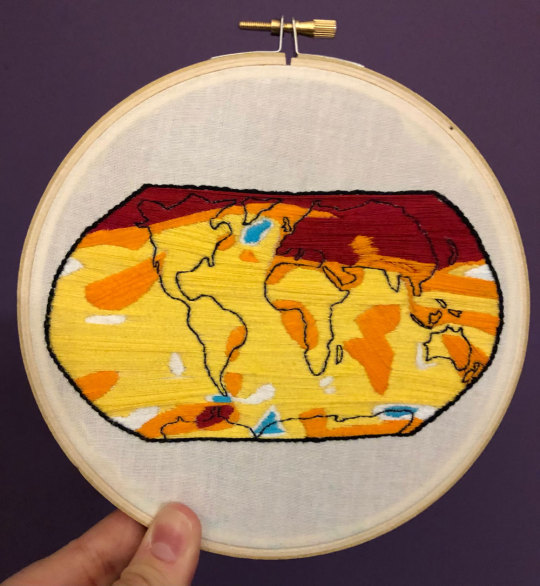
Katy Mersmann, a NASA social media specialist, created this embroidered piece based on NASA’s Goddard Institute for Space Studies (GISS) global annual temperature record. Earth’s average surface temperature in 2020 tied with 2016 as the warmest year on record. Credit: Katy Mersmann, NASA
Katy Mersmann is a social media specialist at NASA’s Goddard Space Flight Center in Greenbelt, Md. She started embroidering when she was in graduate school. Many of her pieces are inspired by her work as a communicator. With climate data in particular, she was inspired by the researchers who are doing the work to understand how the planet is changing. The GISTEMP piece above is based on a data visualization of 2020 global temperature anomalies, still currently tied for the warmest year on record.
In addition to embroidery, NASA continues to inspire art in all forms. Check out other creative takes with Landsat Crafts and the James Webb Space telescope public art gallery.
Make sure to follow us on Tumblr for your regular dose of space!
#NASA#creativity#fiber art#embroidery#art#art challenge#needlework#crafts#handmade#textile art#cross stitch#stitching#inspiration#inspo#Earth#Earth science#Hubble#James Webb Space Telescope#climate change#water#nebula#stars
6K notes
·
View notes
Text
New data from NASA’s James Webb Space Telescope has revealed that K2-18 b, an exoplanet nearly nine times the size of Earth, could be an example of a theorized class of planets with hydrogen-rich atmospheres, vast liquid oceans and the potential to support life. Observations taken by the telescope detected the presence of carbon-bearing molecules such as methane and carbon-dioxide, according to a NASA press release published on Monday. Astronomers also picked up signs of a molecule called dimethyl sulfide (DMS) – which, on Earth, is only produced by living things. K2-18 b is an exoplanet orbiting a dwarf star roughly 120 light years away from Earth in the constellation of Leo. It is categorized as a sub-Neptune, a class of planets that are between the size of Earth and Neptune and common in the universe, although not in our solar system. Scientists have known about K2-18 b for a while, with initial observations taken by NASA’s Hubble Space Telescope, but these new observations taken with the James Webb Telescope have provided details that astronomers had previously only wondered about. "Our findings underscore the importance of considering diverse habitable environments in the search for life elsewhere," Nikku Madhusudhan, an astronomer at the University of Cambridge and lead author of a paper announcing these results, said in the release. "Traditionally, the search for life on exoplanets has focused primarily on smaller rocky planets, but the larger Hycean worlds are significantly more conducive to atmospheric observations."
Continue Reading
463 notes
·
View notes
Photo

M74 346 !
Combining data from some of NASA’s most powerful instruments, four new composites highlight the enormity of the cosmos in unprecedented detail. Imagery from the Chandra Observatory and the James Webb and Hubble telescopes—plus infrared information from the Spitzer telescope’s final missions—mesh together to generate mesmerizing views of iconic nebulae and galaxies.
Composite X-ray: Chandra: NASA/CXC/SAO, XMM: ESA/XMM-Newton; IR: JWST: NASA/ESA/CSA/STScI, Spitzer: NASA/JPL/CalTech; Optical: Hubble: NASA/ESA/STScI, ESO; Image Processing: L. Frattare, J. Major, N. Wolk, and K. Arcand
#art#photography#space photography#M74 356#Xray#chandra#nasa#space#cosmos#cosmic#universe#james webb#chandra telescope#spitzer#nebulae#galaxy
221 notes
·
View notes
Text
A MISSING PIECE IN THE BIG BANG THEORY HAS SURFACED??
Blog#411
Wednesday, June 19th, 2024.
Welcome back,
Combining different pieces from Big Bang cosmology could help explain an issue we have today.
The Hubble constant, the speed of expansion of our universe, is not observed with consistency.
These scientists suggest that not-well-understood quantum gravity could account for the gap.
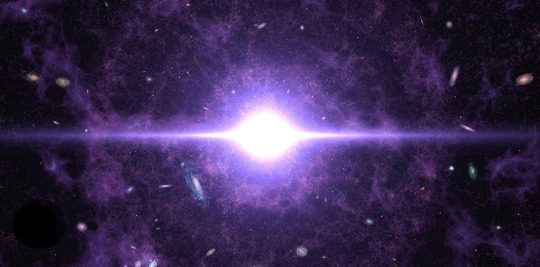
In research published earlier this year, physicists from the University of Hyderabad in India say they’re on the path to solving one of the universe’s biggest outstanding problems. Since Edwin Hubble realized the universe is always expanding nearly 100 years ago, scientists have used the “Hubble constant” in calculations on virtually every scale in the universe.
But today, estimates for the Hubble constant don’t always align, with a difference of up to 10 percent between calculations made using different methods. (When someone at NASA mixes up meters and yards and loses an entire spacecraft, that’s not even a full 10 percent deviation.)
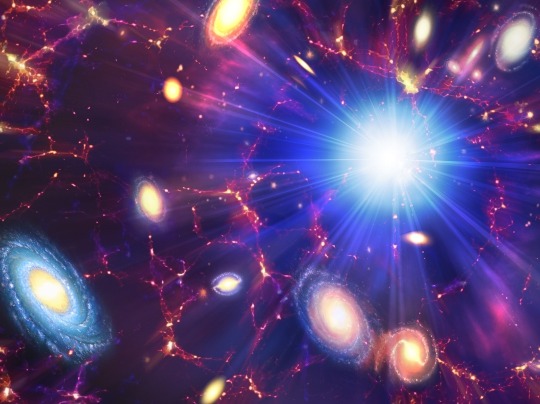
The paper appears in the peer reviewed journal Classical and Quantum Gravity. The journal has an ongoing, periodically updated “focus issue” specifically about this measurement tension, and the editors explain the problem there—scientists can’t say for sure that the different Hubble constants measured are actually different, rather than just observation or calibration issues.
But the authors of the new paper, physicist P.K. Suresh and his research fellow (referred to as just Anupama B.) say that most measurements taken now are reliable. Instrumentation only continues to improve—we’ve all seen those generation-defining, poster-quality photos of the far-out planets, for example. If the measurements on the local and faraway levels are indeed sound, then something is missing.

It’s here where they introduce quantum gravity as a possible factor. This variable—which, to be honest, is another enigmatic “placeholder” in some ways—could close the gap in Hubble constant observations. That’s because, as the authors propose, quantum gravity could have affected the rate of change at which the universe expanded itself. When a constant can have a variable rate of change, it’s easy to see why researchers tend to drop the ‘constant’ label and instead call the fatcor simply H0, H1, and so on to designate which version of the measurement is in play.

The researchers explain that during inflation—the rapid growth of the universe immediately following the Big Bang—there may not have been a single, uniform inflation zone. Instead, more and more scientists are theorizing around the idea of “multi field” inflation. The idea originated to explain another measurement discrepancy: the number of particles in particular places or times, compared with the massive speed of inflation overall.

If a theory could help explain one gap in our codified equations for how inflation works, it makes sense to try that theory to find other missing pieces. These researchers used what is called the hybrid inflationary model, which describes two fields: one inflating and one rolling over like a waterfall. By accounting for quantum gravity, they found they were able to reconcile H0—the current Hubble constant—with both H1 (during inflation) and HT (during phase transition). Just one adjusted equation with a parameter for quantum gravity could draw a curve that includes all three data points.
Originally published on www.popularmechanics.com
COMING UP!!
(Saturday, June 22nd, 2024)
"WHAT IS THE OLDEST BLACK HOLE IN OUR UNIVERSE??"
#astronomy#outer space#alternate universe#astrophysics#universe#spacecraft#white universe#space#parallel universe#astrophotography
74 notes
·
View notes
Note
Did you see that Neptune isn’t actually deep blue?


I hadn't seen this yet, that'll make the name confusing for future generations.
I'm (absolutely not) gonna firebomb the offices of the people that came out with this if they blame Voyager II for this, JPL gave us 2 probes that were designed to get us good views of Jupiter and Saturn and if all went well the 2nd one was gonna keep going to get Uranus and Neptune, and it did it without its high gain antenna that crapped out before it had even made it past the orbit of Mars.
And now nearly 48 years later they're still sending back science, and carrying the little American flag that JPL sneaks into every probe they make.

American Flag Farthest From Home Is Leaving Solar System
published July 3, 2010
USA USA USA

reason why the colours are off is under the cut here, it's a human thing but not really an error.
Surprised this hasn't come up in any of the multitude of hours worth of different documentaries I watched and information I've read over the years, including since this was published.
This is actually very cool, thank you for letting me know about this one, might have to go poke round some and see what else I'm behind on now.
The researchers rebalanced composite color images taken by the Voyager 2 camera, using data from instruments on the Hubble Space Telescope as well as the European Southern Observatory's Very Large Telescope.
The resulting images more accurately reflect the true colors of these planets, says Irwin, as they'd be seen by the naked eye.
As a result, some of the key features of Neptune, such as cloud bands and a dark spot, become "indistinct and difficult to see," he says, noting that the Voyager team deliberately processed its images in a way that would highlight the unusual features of this planet.
"This is a very common thing to do. You're effectively trying to tell a story and to point out to your audience what the interesting features of those images might be," says Leigh Fletcher, an astronomer with the University of Leicester. "But even amateur astronomers looking through their own backyard telescopes up at Uranus and Neptune knew that the contrast in colors between those two worlds was rather more subtle than maybe the original NASA's images first let on."
Although Voyager scientists were open about how they processed their images, says Irwin, the subtleties of those decisions have gotten lost over the decades as the images of Neptune and Uranus have been endlessly reproduced.
"People now just think, 'Well, that's how they look,'" Irwin says, adding that when people see his team's new vision of Neptune, they're "quite surprised."
8 notes
·
View notes
Text

Webb captures Neptune's auroras for the first time
For the first time, the NASA/ESA/CSA James Webb Space Telescope has captured bright auroral activity on Neptune. Auroras occur when energetic particles, often originating from the Sun, become trapped in a planet’s magnetic field and eventually strike the upper atmosphere. The energy released during these collisions creates the signature glow.
In the past, astronomers have seen tantalizing hints of auroral activity on Neptune. However, imaging and confirming the auroras on Neptune has long evaded astronomers despite successful detections on Jupiter, Saturn, and Uranus. Neptune was the missing piece of the puzzle when it came to detecting auroras on the giant planets of our Solar System. Now, Webb’s near-infrared sensitivity has observed this phenomenon.
The data was obtained in June 2023 using Webb’s Near-Infrared Spectrograph. In addition to the image of the planet, astronomers obtained a spectrum to characterise the composition and measure the temperature of the planet’s upper atmosphere (the ionosphere). For the first time, they found an extremely prominent emission line [1] signifying the presence of the trihydrogen cation (H3+), which can be created in auroras. In the Webb images of Neptune, the glowing aurora appears as splotches represented in cyan.
The auroral activity seen on Neptune is noticeably different from what we are accustomed to seeing here on Earth, or even Jupiter or Saturn. Instead of being confined to the planet’s northern and southern poles, Neptune’s auroras are located at the planet’s geographic mid-latitudes — think where South America is located on Earth.
This is due to the strange nature of Neptune’s magnetic field, originally discovered by NASA’s Voyager 2 in 1989, which is tilted by 47 degrees from the planet’s rotation axis. Since auroral activity is based where the magnetic fields converge into the planet’s atmosphere, Neptune’s auroras are far from its rotational poles.
The ground-breaking detection of Neptune’s auroras will help us understand how Neptune’s magnetic field interacts with particles that stream out from the Sun to the distant reaches of our solar system, a totally new window in ice giant atmospheric science.
From the Webb observations, the science team also measured the temperature of the top of Neptune’s atmosphere for the first time since Voyager 2’s flyby. The results hint at why Neptune’s auroras remained hidden from astronomers for so long: Neptune’s upper atmosphere has cooled by several hundreds of degrees.
Through the years, astronomers have predicted the intensity of Neptune’s auroras based on the temperature recorded by Voyager 2. A substantially colder temperature would result in much fainter auroras. This cold temperature is likely the reason that Neptune’s auroras have remained undetected for so long. The dramatic cooling also suggests that this region of the atmosphere can change greatly even though the planet sits over 30 times farther from the Sun compared to Earth.
Equipped with these new findings, astronomers now hope to study Neptune with Webb over a full solar cycle, an 11-year period of activity driven by the Sun’s magnetic field. Results could provide insights into the origin of Neptune’s bizarre magnetic field, and even explain why it’s so tilted.
These observations were obtained as part of Guaranteed Time Observations in programme 1249 (PI: L. Fletcher). The team’s results have been published in Nature Astronomy.
Notes
[1] A bright line in a spectrum caused by emission of light. Each chemical element emits and absorbs radiated energy at specific wavelengths. The collection of emission lines in a spectrum corresponds to the chemical elements contained in a celestial object.
IMAGE:
At the left, an enhanced-color image of Neptune from the NASA/ESA Hubble Space Telescope. At the right, that image is combined with data from the NASA/ESA/CSA James Webb Space Telescope. The cyan splotches, which represent auroral activity, and white clouds, are data from Webb’s Near-Infrared Spectrograph (NIRSpec), overlaid on top of the full image of the planet from Hubble’s Wide Field Camera 3.
Auroras occur when energetic particles, often originating from the Sun, become trapped in a planet’s magnetic field and eventually strike the upper atmosphere. The energy released during these collisions creates the signature glow.
Webb’s detection of auroras on Neptune is the first time astronomers have captured direct evidence of this phenomenon on the planet most distant from the Sun. In addition to the visible glow in the imagery, the spectrum from Webb also found an extremely prominent emission line signifying the presence of the trihydrogen cation (H3+), which can be created in auroras.
Neptune’s auroras do not occur at the northern and southern poles of the planet, where we see auroras on planets like Earth and Jupiter, because of the strange nature of Neptune’s magnetic field, which is tilted by 47 degrees from the planet’s rotational axis.
Webb’s study of Neptune also revealed that the planet’s upper atmosphere has cooled by several hundred degrees, likely the reason that Neptune’s auroras have remained undetected for so long.
13 notes
·
View notes